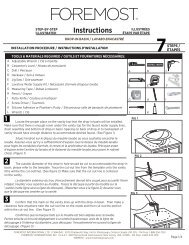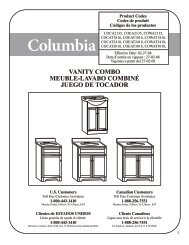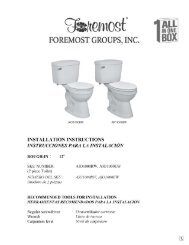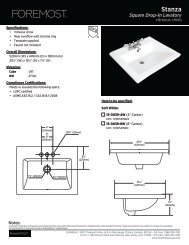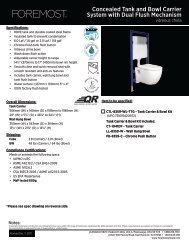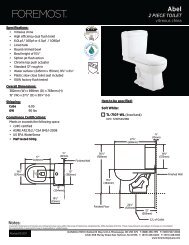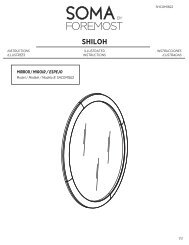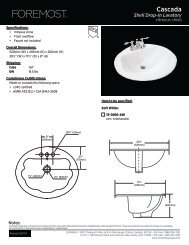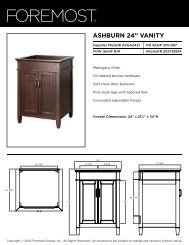WaterSense PDF - Foremost
WaterSense PDF - Foremost
WaterSense PDF - Foremost
Create successful ePaper yourself
Turn your PDF publications into a flip-book with our unique Google optimized e-Paper software.
<strong>WaterSense</strong> SM Tank-Type High-Efficiency Toilet Specification<br />
<strong>WaterSense</strong> ® Tank-Type High-Efficiency Toilet Specification<br />
I. Introduction<br />
The <strong>WaterSense</strong> Program released its performance specification for tank-type high-efficiency<br />
toilets (HETs) (Specification) on January 24, 2007, to promote and enhance the market for<br />
water-efficient toilets. The goal of this Specification is to differentiate products in the<br />
marketplace that meet this Specification’s criteria for efficiency and performance and help<br />
consumers identify these water-efficient products.<br />
This Specification addresses toilets typically found in homes, and in light commercial settings,<br />
such as hotels and restaurants. It does not address valve-type commercial toilets typically found<br />
in public restrooms (e.g., airports, theaters, arenas, schools) or composting toilets, both of which<br />
have different designs, patterns of use, and performance requirements.<br />
II. Current Status of Toilets<br />
<strong>WaterSense</strong> estimates there are currently 222 million residential toilets in the United States.<br />
This estimate is based on an assumed one-to-one ratio of toilets to bathrooms. 1 In addition to<br />
the existing stock, approximately 10 million new toilets are sold each year for installation in new<br />
homes or replacement of aging fixtures in existing homes. 2 Residential toilets account for<br />
approximately 30 percent of indoor residential water use in the United States—equivalent to<br />
more than 2.1 trillion gallons of water consumed each year. 3<br />
The Energy Policy Act of 1992 established the maximum flush volume for all gravity tank-type,<br />
flushometer tank, and electromechanical hydraulic toilets at 1.6 gallons per flush (gpf). These<br />
requirements are codified in the Code of Federal Regulations at 10 CFR Part 430 (specifically<br />
§430.32(q) Water Closets). Federal regulations also require that all toilets sold in the United<br />
States be tested and certified in accordance with the test requirements specified in American<br />
Society of Mechanical Engineers (ASME) A112.19.2–Vitreous China Plumbing Fixtures and<br />
Hydraulic Requirements for Water Closets and Urinals. All dual-flush toilets sold in the United<br />
States also must comply with ASME A112.19.14–Six-Liter Water Closets Equipped with a Dual<br />
Flushing Device.<br />
In addition, there are several voluntary, non-certification toilet testing programs. These tests are<br />
frequently required by water utilities for toilets to qualify for rebates under local water<br />
conservation toilet replacement programs. Two of the most popular and widely used voluntary<br />
testing programs in North America are the Maximum Performance (MaP) Testing of Popular<br />
Toilet Models and the Los Angeles Department of Water and Power Requirements for Ultra-<br />
Low-Flush-Toilets, Supplementary Purchase Specification to ASME A112.19.2 (LADWP SPS).<br />
1<br />
U.S. Census Bureau, American Housing Surveys for the United States, 1970-2003.<br />
2<br />
Plumbing Fixtures market Overview: Water Savings Potential for Residential and Commercial Toilet and<br />
Urinals. D&R International. September 30, 2005<br />
3<br />
Mayer, Peter W. and William B. DeOreo. Residential End Uses of Water. Aquacraft, Inc. Water<br />
Engineering and Management. American Water Works Association. 1998.<br />
1 February 9, 2007
<strong>WaterSense</strong> SM Tank-Type High-Efficiency Toilet Specification<br />
MaP is entirely performance based, testing a toilet’s maximum ability to remove waste starting<br />
with a 50 gram soybean paste sample and increasing at 50 gram intervals. A minimum passing<br />
score is 250 grams. The LADWP SPS requires the use of durable, chemical-resistant flush<br />
valve seals, and restricts maximum flush volumes under maximum trim adjustment and<br />
pressure conditions.<br />
One problem with the number of different voluntary toilet testing programs in existence was the<br />
lack of uniformity or consistent requirements. Manufacturers found it difficult and costly to<br />
develop products that met the requirements of multiple testing programs, and water authorities<br />
were unsatisfied with the limited availability of qualified products. Consumers found the<br />
patchwork of toilet specifications, requirements, and “approved toilet lists” confusing at best. To<br />
remedy this situation, in 2004, members of the plumbing industry and water utilities combined<br />
the MaP Testing and LADWP SPS standards to create the Uniform North American<br />
Requirements (UNAR) for Toilet Fixtures: Guidelines and Specifications. UNAR is a voluntary<br />
system for qualifying toilet fixtures that achieve sustainable water savings and ensure a high<br />
level of customer satisfaction with flushing performance.<br />
In developing this Specification, <strong>WaterSense</strong> adopted the framework of the UNAR standard<br />
while making several significant changes to the water-efficiency and performance criteria.<br />
<strong>WaterSense</strong> estimates that there are currently 68 toilet models on the market that meet the<br />
requirements of this specification and would be qualified to apply for and use the <strong>WaterSense</strong><br />
label.<br />
III. <strong>WaterSense</strong> Tank-Type High-Efficiency Toilet Specification<br />
Scope<br />
The <strong>WaterSense</strong> Program developed this Specification to address criteria for improvement and<br />
recognition of water-efficient and high-performance tank-type toilets. These toilets are<br />
commonly found in residential and light commercial settings and include the standard gravity<br />
type found in most homes, pressure assisted, and electrohydraulic assisted toilets. The majority<br />
of these fixtures are single flush toilets, toilets with one constant flush volume, though an<br />
increasing number of dual flush models are coming to market. Dual flush toilets have two flush<br />
volumes—a full flush for solids and a reduced flush for liquids only. <strong>WaterSense</strong> initially focused<br />
on residential toilets because they are the largest water consuming fixture in homes.<br />
Commercial valve-type (a.k.a., flushometer valve) toilets were excluded from this specification<br />
because of their differing design, patterns of use, and performance expectations. Commercial<br />
valve-type toilets are tankless, relying on water pressure controlled by flushing valves to remove<br />
waste rather than gravity. Because of the fundamental difference in design, a different set of<br />
technical requirements is needed. Commercial valve-type toilets also have a different pattern of<br />
use than residential or light commercial tank-type toilets and will likely require different<br />
performance specifications. For example, the test media needing to be cleared by a commercial<br />
valve-type toilet may need to include a paper toilet seat cover and potentially more paper. If<br />
<strong>WaterSense</strong> decides to address this type of toilet, it will do so under a separate specification at<br />
a later time.<br />
Water Efficiency Criteria<br />
2 February 9, 2007
<strong>WaterSense</strong> SM Tank-Type High-Efficiency Toilet Specification<br />
The water-efficiency component of the Specification establishes a maximum effective flush<br />
volume of 1.28 gpf for all HETs. This value represents a 20 percent reduction from the current<br />
1.6 gpf standard and is consistent with <strong>WaterSense</strong>’s stated goal of increasing product<br />
efficiency by at least 20 percent. Under this Specification, there are two ways by which an HET<br />
can meet the effective flush volume criteria:<br />
• Single flush toilet must use 1.28 gpf or less; or<br />
• Dual flush toilets must have a full flush no more than 1.6 gpf and a reduced flush no<br />
more than 1.1 gpf. Field studies indicate that in actual use such toilets will flush 1.28 gpf<br />
or less, on average.<br />
Performance Criteria<br />
In light of the history of poor performance and user dissatisfaction with several of the early 1.6<br />
gpf ultra-low flush (ULF) toilets in the early 1990’s, <strong>WaterSense</strong> wanted to ensure that<br />
<strong>WaterSense</strong> labeled HETs consistently perform at a high level and meet or exceed user<br />
expectations. The Flush Performance Criteria (Section 4.0) of the Specification ensures this<br />
level of performance and is based on the UNAR standard, with two key differences. First, the<br />
<strong>WaterSense</strong> specification increased the mass of the soy bean paste test media from 250 grams<br />
to 350 grams. <strong>WaterSense</strong> decided to make the Specification more rigorous in order to<br />
establish a higher level of performance for HETs and ensure customer satisfaction with these<br />
products.<br />
Second, <strong>WaterSense</strong> also decided to switch from cased media, as used in UNAR, to an<br />
uncased media. Several manufacturers reported variability in test results when using cased<br />
media and expressed concern over the sample reliability. In addition, the primary justification for<br />
using cased media—reusability to save time and reduce costs—while important requirements in<br />
a research and development mode when many repeated tests are performed, were not as<br />
critical in regards to this HET specification, as a maximum of only five tests are required. The<br />
uncased media provides a more realistic sample and has a more established testing track<br />
record. For these reasons, <strong>WaterSense</strong> adopted the use of uncased media.<br />
Potential Water Savings<br />
The 222 million residential toilets in use today are a mix of the current standard 1.6 gpf fixtures<br />
and older, pre-1992 models. Water consumption in these older models range from 3.5 gpf to<br />
more than 5.0 gpf, depending on age and model. Table 1 provides a breakdown of the mix of<br />
the existing toilet stock.<br />
To estimate the potential water savings impact of HETs, <strong>WaterSense</strong> assumed that the average<br />
person flushes 5.1 times per day at home. 4 With an estimated population of 296 million people<br />
in the United States and 222 million residential toilets in use, this equates to 6.8<br />
flushes/toilet/day (see Calculation 1). Assuming that 10 percent of the existing 222 million toilets<br />
in the United States could reasonably be expected to be replaced with <strong>WaterSense</strong> labeled<br />
HETs, the total daily savings potential is approximately 246 million gallons per day (see Table 1<br />
and Calculation 2). This equates to more than 89.7 billion gallons each year (see Calculation 3).<br />
4 Peter W. Mayer and William B, DeOreo. Residential End Uses of Water. Aquacraft, Inc. Water<br />
Engineering and Management. American Water Works Association. 1998. p. 94.<br />
3 February 9, 2007
<strong>WaterSense</strong> SM Tank-Type High-Efficiency Toilet Specification<br />
Calculation 1.Average Daily Flushes per Toilet<br />
(5.1 flushes/person/day)(2.96 x 10 8 people) / (2.22 x 10 8 toilets) = 6.8 flushes/toilet/day<br />
Table 1. Number of Toilets by Flush Volume and Potential Savings 5<br />
GPF # of toilets (millions) # of toilets replaced given<br />
10% replacement of<br />
existing fixtures (millions)<br />
Savings per flush by<br />
switching to 1.28 HET<br />
(gpf)<br />
5.0 67 6.7 3.72<br />
3.5 33 3.3 2.22<br />
1.6 122 12.2 0.32<br />
Total 222 22.2 —<br />
Calculation 2.Total Daily Savings<br />
(If 10% of all existing toilets replaced with 1.28 gpf HET)<br />
5.0 gpf: (6.7 x 10 6 toilets) (3.72 gpf) (6.8 flushes/toilet/day) = 169,483,200 gallons/day<br />
3.5 gpf: (3.3 x 10 6 toilets) (2.22 gpf) (6.8 flushes/toilet/day) = 49,816,800 gallons/day<br />
1.6 gpf: (12.2 x 10 6 toilets) (0.32 gpf) (6.8 flushes/toilet/day) = 26,547,200 gallons/day<br />
Total Daily Savings 245,847,200 gallons/day<br />
Calculation 3.Total Annual Savings<br />
(245,847,200 gallons/day) (365 days/year) = 89,734,228,000 gallons/year<br />
89.7 billion gallons/year<br />
5 Plumbing Fixtures market Overview: Water Savings Potential for Residential and Commercial Toilet and<br />
Urinals. D&R International. September 30, 2005<br />
4 February 9, 2007



